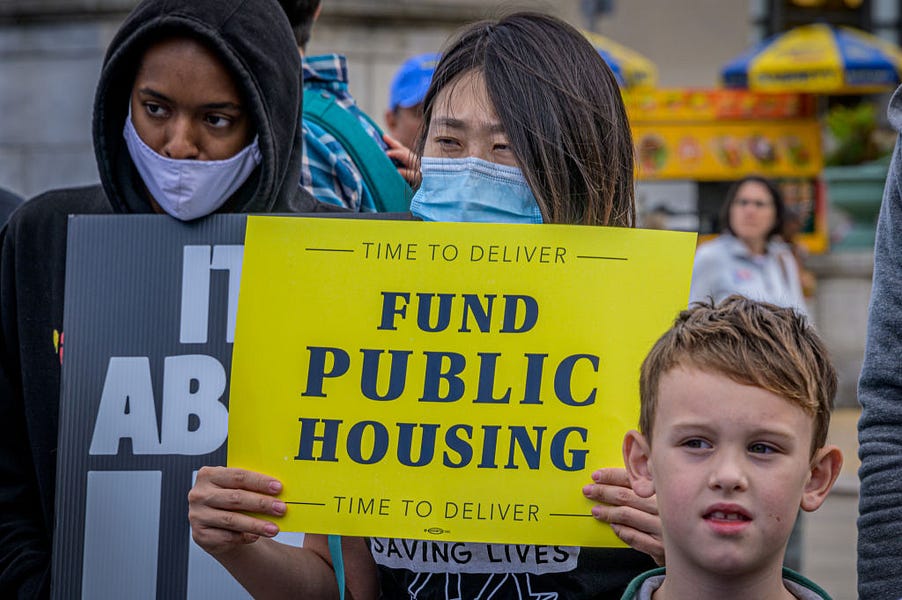Happy Friday morning. It was a recess week for Congress, but the Uphill team spent it slogging through more of the sweeping Build Back Better Act.
We brought you details of the package’s climate provisions last week. We hope you found it useful, if not riveting, reading material. We enjoyed reading your thoughts about various items in the bill in the comments.
Today, we’re examining the bill’s health and housing policies. This is not comprehensive, but it is a more detailed look at the bill than you may find elsewhere. We relied on the latest version from the House, but it’s worth emphasizing that some of this could change in the coming weeks.
If you want to read the legislation yourself, it is available here. A section-by-section analysis from the House Budget Committee is available here.
Health
School meals: The legislation includes provisions to expand access to free school meals through the 2026-27 school year. It takes steps to reimburse more schools through the Community Eligibility Provision, which grants free breakfast and lunches at no cost to students in low-income areas. The House Education and Labor Committee estimates 9 million more students will be able to access free meals because of these sections of the bill.
The package also expands a program to give benefits to low-income children across the country during the summers of 2023 and 2024 to help them afford food in the absence of regular free school meals. Eligible households would receive $65 per month for each child.
The Agriculture Department tested this program in several sites with participation from eight states and two Native American tribal organizations each summer from 2011 to 2014, with a monthly amount ranging from $60 to $30. Researchers found that the $60 benefit reduced the most severe kind of food insecurity among children by 33 percent.
Also in the bill are $250 million in grants for schools to boost healthy food options and lifestyles, such as buying more nutritious ingredients and conducting nutrition education programs.
Build Back Better directs $30 million through the end of September 2030 to assist schools in purchasing kitchen equipment.
Maternal health: $100 million would go toward addressing maternal mortality in areas with high rates of adverse maternal health outcomes. This involves hiring and training staff and promoting health literacy and education for pregnant and postpartum women, among other activities. An additional $75 million would support organizations in areas with high rates of maternal mortality or with significant racial disparities in maternal health.
The bill also seeks to grow the perinatal nursing workforce, directing $170 million in grants to nursing schools specifically for boosting the capacity of perinatal nurses. The grant funds could be used to offer scholarships to students planning to focus on maternal health, obstetrics and gynecology, or seeking to become certified nurse midwives.
$50 million more would go toward programs to improve perinatal care. The bill also directs $50 million to grants to expand doula training programs.
$100 million would go toward grants to address mental health conditions and substance use disorders among pregnant and postpartum women. The package also funds efforts to grow the maternal mental health workforce to the tune of $75 million.
The legislation requires Medicaid and the Children’s Health Insurance Program to provide full benefits for pregnant and postpartum women for the year after pregnancy.
It also includes $75 million to fund the Pregnancy Assistance Fund through the end of fiscal year 2024. The program supports teen parents and young families through grants to states and organizations. Beneficiaries can receive help with their own health, the health of their child, parenting, education, and employment. It also provides necessities like diapers free of charge.
Americans with disabilities: The package includes $10 million to increase access to assistive technologies for people with disabilities.
The legislation also directs $25 million to the Department of Health and Human Services to distribute as grants to address behavioral health needs of those with intellectual or developmental disabilities.
Domestic violence: $30 million would go to grants for sexual assault survivors and to prevent family violence.
Older Americans: The package includes $1.2 billion for programs carried out under the Older Americans Act, including aging services, support for senior centers, research, nutrition programs for older Americans, and assistance for long-term care.
Drug prices: Beginning in January 2023, the legislation would require group health plans and insurers to cover the prices of specific insulin products—pre-deductible and with a $35 cap on consumers’ cost-sharing burden for a 30-day supply of the drug. These requirements do not apply to insulin from out-of-network providers. Under the bill, the out-of-pocket costs consumers face from their insulin purchases would count toward their plans’ deductibles.
The package also empowers Medicare to negotiate prices of the costliest drugs with pharmaceutical manufacturers. Starting in 2025, 10 drugs would have renegotiated prices, increasing to 15 drugs in 2026, 15 more in 2027, and then 20 drugs for each year after. This is less ambitious than prior Democratic proposals, with concessions both on the scope of the program and which drugs are exempt from negotiation. Some Democratic lawmakers had raised concerns about the plan reducing revenue for pharmaceutical companies, leading to potential losses in the ability to conduct research and development for new drugs.
The legislation imposes price ceilings for the government’s purchases of various drugs, beginning at 75 percent of the average commercial costs of drugs that have been on the market for nine to 12 years. That percentage decreases the longer a given medication has been on the market. The legislation also includes tax penalties for pharmaceutical companies if they raise prices higher than inflation. The ability to negotiate drug prices is expected to save the government a substantial amount of money—the White House reportedly estimates savings of $250 billion from these provisions, although a more detailed score from the nonpartisan Congressional Budget Office is not yet available.
More information on the background of the debate and how these provisions changed from earlier versions of the bill is available here, from Vox’s Dylan Scott.
Beginning in 2024, the package also caps the yearly out-of-pocket costs of prescription drugs for seniors and people with disabilities under Medicare Part D at $2,000.
Medicare: Beginning in January 2023, hearing treatment would be covered under Medicare. It would also cover hearing aids once every five years for people with moderately severe, severe, or profound hearing loss in one or both ears. Previous versions of the bill included coverage for dental care, but that was removed in the latest version. CNBC has a helpful rundown of Medicare costs and coverage under current law compared to Build Back Better, available here.
Medicaid and children’s health care: The legislation boosts federal assistance to states for improvements and expansions of Medicaid’s home and community-based services. This enables access to health care services at home, benefitting people with disabilities or mental illnesses, among other populations. $130 million in grants would go to states to improve HCBS. It also makes permanent a program that helps Medicaid beneficiaries transition from receiving care at institutions to receiving care at home or in their communities.
The package also increases Medicaid funding for the territories.
The bill extends Medicaid coverage to people in prison 30 days before their release. It also requires states to provide a full year of eligibility to children enrolled in Medicaid and CHIP. This is intended to prevent gaps in coverage in the event that their family’s income increases above the eligibility threshold for benefits.
It also permanently funds the Children’s Health Insurance Program. Federal grants for the program are currently authorized through September 2027.
State funds: The bill makes $30 billion available to states from 2023 through 2025—$10 billion per year—to establish state reinsurance programs or to provide assistance to residents to reduce health care costs.
The legislation also includes $50 million for Section 1332 waivers, which allow states to alter how they carry out some provisions of the Affordable Care Act. The grants are capped at $5 million per state. The waivers can be approved if a given state’s proposal demonstrates it will provide coverage at least as comprehensive and affordable, cover a comparable number of residents, and will not increase the federal deficit.
Most of the states that have obtained waivers thus far have used it for state reinsurance programs. More background is available here, from the nonpartisan Congressional Research Service.
Public health: The bill includes $7 billion through September 2026 in grants to state and local governments to support public health. Applicable activities include efforts to improve preparedness, testing capacity, contact tracing, health information systems and analysis, and epidemiology and disease surveillance, among other items.
The bill also directs $3.37 billion for graduate medical education programs and $2 billion for health center facility improvements. The National Health Service Corps would receive $2 billion.
It also includes $500 million for the Nurse Corps, which assists nursing students who commit to work in areas with nurse shortages. An additional $500 million would go toward medical schools in underserved communities. $500 million more is included for modernizing nursing education programs and to increase faculty. A combined $85 million would go to various programs to support palliative medicine education and training.
$75 million is directed to the National Institutes of Health to boost research at historically black colleges and universities. $10 million is included for the NIH to carry out research on developmental delays in children.
The legislation also provides $75 million for treatment and services to communities impacted by HIV/AIDS. $60 million more would go to grants to prevent and control sexually transmitted diseases.
The package supports the World Trade Center Health Program, which monitors and treats health conditions related to the 9/11 attacks at no cost. The program would receive supplemental funds of $2.86 billion through September 2031.
Pandemic preparedness: $1.4 billion is included for the Centers for Disease Control and Prevention for laboratory renovations and improvements. An additional $1.3 billion is dedicated to preparedness, such as vaccine production capacity and preventing supply chain problems.
Mental health: $50 million would go toward scholarships to educate health care professionals about mental health and substance use disorders, with a focus on racial and ethnic minorities. The bill also sends $25 million to recovery community organizations and $15 million to promote public awareness about mental health issues among school children and school faculty.
The National Suicide Prevention Lifeline would also receive $75 million for its operations helping people in crisis.
$2.5 billion is directed to public health interventions to respond to trauma, particularly for areas with high rates of violence. The money would be distributed in the form of grants for activities such as conflict mediation and mental health counseling.
Housing
The plan would also spend more than $150 billion to expand and improve the nation’s stock of affordable housing, and seek to make home ownership more accessible for Americans.
It includes $65 billion to grow the overall supply of public housing. It would invest $2.25 billion to improve existing public housing. Funds would also be used to address health and safety issues including lead, carbon monoxide, mold, asbestos, and other hazards.
The HOME Investment Partnership Program, a federal block grant program under the umbrella of the Department of Housing and Urban Development, would get $10 billion. HOME partners with states and localities to build, purchase, and repair affordable homes for low-income families.
The legislation also would create a new Housing Investment Fund to the tune of $750 million, which would partner with community development financial institutions (CDFI), as well as private developers. Under this program, nonprofits and organizations such as banks, credit unions, and venture capital firms that are eligible for CDFI certification would be able to unlock additional federal funds to make it easier to funnel investments into low-income and underfinanced communities.
A HUD program that provides rental assistance to low-income Americans with disabilities would receive $500 million. Another $500 million would go towards rental assistance and other services for elderly Americans in need of affordable housing.
The bill appropriates around $2 billion to a grant program to make energy and water consumption more efficient, improve indoor air quality, and make other upgrades at multifamily properties.
HUD would also receive around $1.6 billion for owners of “distressed properties” to help improve safety and health conditions. Rural rental housing would get about $2 billion to improve the health and safety of those properties. That pot of money would also go toward rental assistance for eligible people in rural areas.
The Housing Choice Vouchers program, which assists people with affording their rent, would get $24 billion. According to the progressive Center on Budget and Policy Priorities, about 5 million Americans—primarily low-income, disabled, or senior citizens—use the vouchers. Within the larger pot of money, more than $7 billion is specifically designated for those at risk of homelessness, survivors of domestic or dating violence, sexual assault, and victims of stalking and human trafficking.
Around $1 billion would go to help Native American, Alaskan, and Native Hawaiian communities afford housing, address environmental threats, and develop their communities.
The bill appropriates $5 billion for eliminating lead paint and other hazardous materials in multifamily housing.
Another $1.75 billion provision would create a new program called Unlocking Possibilities, which would fall under HUD’s purview. It would create incentives for localities to reform zoning laws that limit new development.
The legislation also maps out $10 billion to incentivize lenders and financial institutions to make small-dollar mortgages more accessible to first-time homebuyers.









Please note that we at The Dispatch hold ourselves, our work, and our commenters to a higher standard than other places on the internet. We welcome comments that foster genuine debate or discussion—including comments critical of us or our work—but responses that include ad hominem attacks on fellow Dispatch members or are intended to stoke fear and anger may be moderated.
You are currently using a limited time guest pass and do not have access to commenting. Consider subscribing to join the conversation.
With your membership, you only have the ability to comment on The Morning Dispatch articles. Consider upgrading to join the conversation everywhere.